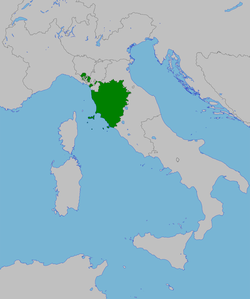
Back دوقية تسكانة الكبرى Arabic Gran Ducáu de Toscana AST Böyük Toskana hersoqluğu Azerbaijani بزرق توسکانی دوکلیغی AZB Вялікае герцагства Тасканскае Byelorussian Велико херцогство Тоскана Bulgarian Dugelezh-veur Toskana Breton Gran Ducat de Toscana Catalan Toskánské velkovévodství Czech Uchel Ddugiaeth Toscana Welsh
Grand Duchy of Tuscany | |
|---|---|
| 1569–1860 | |
| Motto: Sotto una Fede et Legge un Signor solo (Italian) Under one Faith and Law one Lord alone | |
| Anthem: La Leopolda | |
 Borders of the Grand Duchy of Tuscany (1815–1847) | |
 Administrative divisions of the Grand Duchy of Tuscany at the end of 1847 | |
| Capital | Florence 43°N 11°E / 43°N 11°E |
| Common languages | |
| Religion | Roman Catholicism (official) |
| Government |
|
| Grand Duke | |
• 1569–1574 | Cosimo I de' Medici (first) |
• 1859–1860 | Ferdinand IV of Habsburg-Lorraine (last) |
| History | |
• Cosimo I is elevated by a papal bull to Grand Duke of Tuscany | 27 August 1569 |
• End of Medici rule | 9 July 1737 |
| 21 March 1801 | |
| 9 June 1815 | |
• Deposition of the Habsburgs | 16 August 1859 |
• Merged to form the United Provinces of Central Italy | 8 December 1859 |
• Formally annexed to Kingdom of Sardinia after a plebiscite | 22 March 1860 |
| Population | |
• 1801 | 1,096,641[1] |
| Currency |
|
| Today part of | Italy |
The Grand Duchy of Tuscany (Italian: Granducato di Toscana; Latin: Magnus Ducatus Etruriae) was an Italian monarchy that existed, with interruptions, from 1569 to 1860, replacing the Republic of Florence.[2] The grand duchy's capital was Florence. In the 19th century the population of the Grand Duchy was about 1,815,000 inhabitants.[3]
Having brought nearly all Tuscany under his control after conquering the Republic of Siena, Cosimo I de' Medici, was elevated by a papal bull of Pope Pius V to Grand Duke of Tuscany on 27 August 1569.[4][5] The Grand Duchy was ruled by the House of Medici until the extinction of its senior branch in 1737. While not as internationally renowned as the old republic, the grand duchy thrived under the Medici and it bore witness to unprecedented economic and military success under Cosimo I and his sons, until the reign of Ferdinando II, which saw the beginning of the state's long economic decline. It peaked under Cosimo III.[6]
Francis Stephen of Lorraine, a cognatic descendant of the Medici, succeeded the family and ascended the throne of his Medicean ancestors. Tuscany was governed by a viceroy, Marc de Beauvau-Craon, for his entire rule. His descendants ruled, and resided in, the grand duchy until its end in 1859, barring one interruption, when Napoleon Bonaparte gave Tuscany to the House of Bourbon-Parma (Kingdom of Etruria, 1801–1807), then annexed it directly to the First French Empire. Following the collapse of the Napoleonic system in 1814, the grand duchy was restored. The United Provinces of Central Italy, a client state of the Kingdom of Sardinia, annexed Tuscany in 1859. Tuscany was formally annexed to Sardinia in 1860, as a part of the unification of Italy, following a landslide referendum, in which 95% of voters approved.[7]
- ^ United Kingdom of Great Britain and Ireland; House of Commons, John Bowring, 1839, p. 6.
- ^ Strathern, Paul (2003). The Medici: Godfathers of the Renaissance. London: Vintage. ISBN 978-0-09-952297-3. pp. 315–321.
- ^ Ministry of Agriculture, Industry and Commerce (1862). Popolazione censimento degli antichi Stati sardi (1. gennaio 1858) e censimenti di Lombardia, di Parma e di Modena (1857–1858) pubblicati per cura del Ministero d'agricoltura, industria e commercio: Relazione generale con una introduzione storica sopra i censimenti delle popolazioni italiane dai tempi antichi sino all'anno 1860. 1.1 (in Italian). Stamperia Reale.
- ^ "bolla papale di Pio V". archeologiavocidalpassato (in Italian). Retrieved 2021-02-10.
- ^ "Cosimo I | duke of Florence and Tuscany [1519–1574]". Encyclopedia Britannica. Retrieved 2021-02-10.
- ^ "COSIMO III de' Medici, granduca di Toscana". Dizionario Biografico (in Italian). Retrieved 2020-04-25.
- ^ Cite error: The named reference
Heraldicawas invoked but never defined (see the help page).



